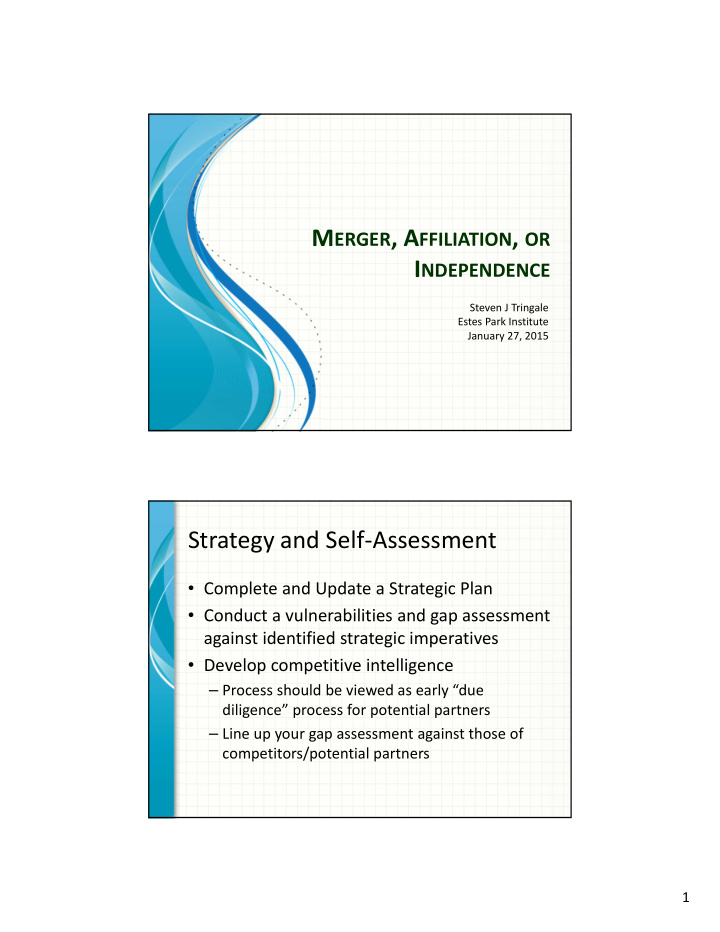



M ERGER , A FFILIATION , OR I NDEPENDENCE Steven J Tringale Estes Park Institute January 27, 2015 Strategy and Self ‐ Assessment • Complete and Update a Strategic Plan • Conduct a vulnerabilities and gap assessment against identified strategic imperatives • Develop competitive intelligence – Process should be viewed as early “due diligence” process for potential partners – Line up your gap assessment against those of competitors/potential partners 1
Strategy and Self ‐ Assessment • Communicate and Educate Results to key internal constituencies – Board – Senior Management Team – Key Physician Leaders (outside of board and senior management) • 1 st Gate – Decision that it is time to explore a collaborative relationship What Are Organizational Goals/Requirements of a Partner • Form Ad Hoc Committee to Review Strategic Collaboration Options – Representatives from board, executive management and physician leadership • Pivoting off strategic plan develop list of key organizational goals for Collaboration • Organize criteria into key areas – Assess areas where there is redundancy & areas that expand your current capabilities 2
What Are Organizational Goals/Requirements of a Partner • Governance and Organizational Structure – Example: Is retaining governance control of local system is a criteria for partnership? • Strategic Positioning of Potential Collaborator – Test against your strategic plans vision of the market as you see it evolving • Business Operation – Collaborator have valuable/unique relationship with payer(s), employers, government What Are Organizational Goals/Requirements of a Partner • Clinical Program – Service lines capabilities and capacity – Potential to support/enhance your operation – Compatibility of referral and teaching relationships • Regulatory Issues – Does potential affiliation pose additional risk and a different standard for approval • Issue should include assessment of partner & potential configuration of collaboration 3
What are Organizational Goals/Requirements of Partner • Cultural Fit – Issue most often cited for reason for failure of a collaboration or dissatisfaction with partner – Qualitative assessment that needs to factored into the quantitative analysis to determine your preferred collaborator • Resist temptation to factor this issue in after selecting potential partner Next Steps – Key Decisions • Are Certain Responses Off The Table – “We will not entertain a full asset merger” – Do we start with least disruptive and intrusive models – Is this a transitional step or end game • Would you grant a potential partner right of first refusal for full asset merger? 4
Next Steps – Key Decisions • Recommend a facilitated process that: – Develops “relative weighting” for criteria of preferred collaborator – Use survey as tool for ad hoc committee – Engage committee in discussion on results – Results increase and validate buy in from ad hoc committee and their representative constituencies – Gate 2: Identify preferred collaborator The Negotiation Process • After Initial Discussion With All Potential Partners – Eliminate – Those that do not optimize your strategic objectives – Those that will not consider your affiliation option of choice – Those where there is a strong belief in mission and/or culture clash – Those that provide an unacceptable risk of regulatory complications or denial 5
The Negotiation Process • Move decisively, control the agenda • Put clearly defined limits on process – time line and confidentiality • Develop strong Communications Plan – Clarity is Essential – Internal and External Messages Consistent • Consider Break Up Fees Closing Observations • Keep focus on option of choice • Maximize future options by agreeing to least intrusive option that meets institutions strategic requirements • Remain flexible and creative – Deal templates are just that – templates/guides • Be prepared to say no • Always have a Plan B!!!! 6
Q UESTIONS ? 7
Recommend
More recommend